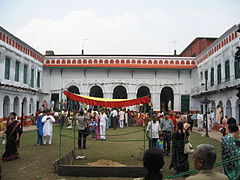Shobhabazar Rajbari
| Shobhabazar Rajbari | |
|---|---|
| শোভাবাজার রাজবাড়ি | |

The thakurdalan inside the "palace".
|
|
| Alternative names | Sovabazar Rajbari |
| General information | |
| Status | Residential building |
| Address | 33 to 36 Raja Nabakrishna Street |
| Town or city | Kolkata |
| Country | India |
| Construction started | Main building: probably predates 1757; Nat Mandap: 1830's |
| Owner | The house: private; Nat Mandap: Kolkata Municipal Corporation |
| Website | |
| Website URL | |
Shobhabazar Rajbari (Shobhabazar Royal Palace) is the palace of the Shobhabazar royal family located in the Indian city of Kolkata. Raja Nabakrishna Deb (1737–97), founder of the Shobhabazar Rajbari (at 35), started life modestly but soon amassed considerable wealth in his service to the British, in particular by his role in assisting to topple Siraj ud-Daulah. During his lifetime Raja Nabakrishna Deb built two houses. The building at 35 Raja Nabakrishna Street (known as Shobhabazar Rajbari or "Baag ola Bari - House with the lions"), on the northern side of the road, was the one first constructed by him, subsequently inherited by his adopted son from his elder brother Gopimohan and his descendants including his son Radhakanta Deb. The house at 33 Raja Nabakrishna Street (known as Choto Rajbari) was built by him when a son was born to him later in life, and was left to his biological son Rajkrishna and his descendants.
Although originally a saat-mahala house the most intact of the remaining spaces is the courtyard with the thakurdalan. A saat khilan thakurdalan with multi-foliate arches supported on pairs of squared pilasters. Pairs of columns with plain shafts rise up between the arches to support the entablature above.
A large central courtyard with the thakurdalan at the northern end. A paanch khilan takurdalan with multifoil arches supported on compound columns. the double storey wings on either side of the courtyard connect the thakurdalan with the naach ghar to the south. The roof of the naach ghar has fallen through and very little of the superstructure remains.
A set of eight massive Tuscan columns support a wide projecting cornice at roof level. Two rows of multifoliate arches at the northern end provide access to the nabaratna temple at the rear.
The main entrance also called the Singhadwar (literal translation: Entrance or door with lions).
A closer view of the Durga idol at Shovabazar Rajbari in 2006.
Old painting of Durga Puja in Kolkata, possibly at Shobhabazar.
...
Wikipedia
